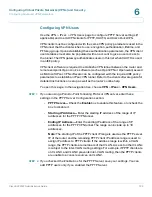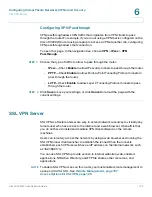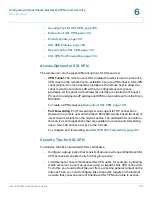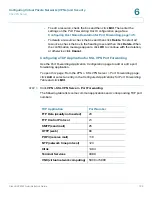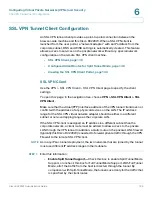
Configuring Virtual Private Networks (VPNs) and Security
SSL VPN Server
Cisco RV220W Administration Guide
124
6
Configuring VPN Passthrough
VPN passthrough allows VPN traffic that originates from VPN clients to pass
through the router. For example, if you are not using a VPN that is configured on the
Cisco RV220W, but are using a laptop to access a VPN at another site, configuring
VPN passthrough allows that connection.
To open this page:
In the navigation tree, choose
VPN
>
IPsec
>
VPN
Passthrough
.
STEP 1
Choose the type of traffic to allow to pass through the router:
•
IPsec
—Check
Enable
to allow IP security tunnels to pass through the router.
•
PPTP
—Check
Enable
to allow Point-to-Point Tunneling Protocol tunnels to
pass through the router.
•
L2TP
—Check
Enable
to allow Layer 2 Tunneling Protocol tunnels to pass
through the router.
STEP 2
Click
Save
to save your settings, or click
Cancel
to reload the page with the
current settings.
SSL VPN Server
SSL VPN is a flexible and secure way to extend network resources to virtually any
remote user who has access to the Internet and a web browser. A benefit is that
you do not have to install and maintain VPN client software on the remote
machines.
Users can remotely access the network by using a web browser and running the
SSL VPN tunnel client launcher to establish the tunnel. When the tunnel is
established, each VPN user will have an IP address on the internal network, such
as 192.168.251.x.
You can use SSL VPN to provide access to internal websites, web-enabled
applications, NT/Active Directory and FTP file shares, other resources, and
applications.
NOTE
To enable SSL VPN access on this router, you must enable remote management to
open port 443 for SSL. See
Remote Management, page 157
.
Access Options for SSL VPN, page 125













